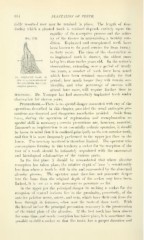Page 656 - My FlipBook
P. 656
654 PLANTATION OF TEETH.
tially rcs()rh(>(l root may be retained in place. Thv ]en
rapidity of the resorptive process and the activ-
FiG. 579. ity of the tissues in maintaining a healthy con-
dition, lieplanted and transplanted teeth have
been known to do good service for from twenty
to forty years. The time of the observation as
to implanted teeth is shorter, the oldest cases
being less than twelve years old. In the writer's
observations, extending over a period of nearly
ten years, a number of teeth have been noted
^vhich havc been retained successfully for that
An implanted tooth in
sto ; «, a, oxcavations of period; how miich longer they will remain ser-
the cemontum due to re- . , , i i , , o '^^
viccablc, and what percentage or success will
sorptive process.
attend later cases, will require further time to
determine. Dr. Younger has had successfully implanted teeth under
observation for eleven years.
Precautions.—There is no special danger connected with any of the
operations described in this chapter, provided the usual antiseptic pre-
cautions are observed and daup-erous anesthetics avoided. Aside from
these, during the operation of replantation and transplantation no
special skill is necessary ; certain precautions are, however, essential.
Inasmuch as implantation is an essentially esthetic operation, it should
be borne in mind that it is confined princijaally to the ten anterior teeth,
and that it is more frequently performed in the upper jaw than in the
lower. The territory involved is therefore limited. The operator who
contemplates forming in this territory a socket for the reception of the
root of a tooth should be intimately acquainted with the anatomical
and histological relationships of the various parts.
In the first place it should be remembered that where alveolar
resorption has taken place, the relative depth of bone is considerably
less than where a tooth is still in situ and surrounded by the abnormal
alveolar process. The operator must therefore not penetrate deeper
into the bone than the original depth of the socket may have been.
Indeed, it is not as a rule necessary to penetrate so far.
In the upper jaw the principal danger in making a socket for the
reception of central incisors lies in the proximity, posteriorly, of the
anterior palatine nerve, artery, and vein, which have their exit from the
bone through its foramen, often near the roots of these teeth. With
the lateral incisor the principal precaution necessary is the preservation
of the labial plate of the alveolus. If the lost tooth has been absent
for some time, and much resorption has taken place, it is sometimes im-
possible to drill a socket so that the tooth has a proper direction and


